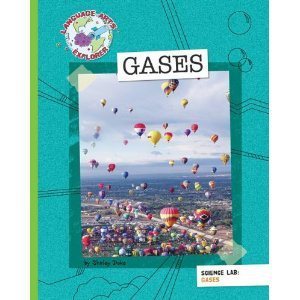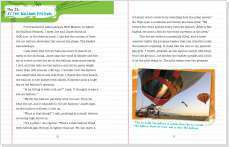GASES
By Shirley Duke
Cherry Lake, 2012 Language Arts Explorer Science Lab
ISBN #978-1-61080-203-1
Grades 4-8
Facts set in real-life, fictional narratives
"Maria Lee is researching gases for an article in Chemistry Kids magazine. She's meeting with experts to learn about gases and what they do. Carry out your mission by reading her journal."
Combining language arts with science is a terrific idea. Writing this book was harder for me than straight science, however. Weaving the facts into fictional, yet real-life situations isn't as easy as I thought it would be. The book turned out to be fun and a fascinating way to integrate reading and science. With many of the testing passages about science, it gives readers a head start in practicing reading in a fun way with fascinating facts.
You can imagine the mirth that greeted me when I announced to my family (all male) I was writing a book about gases. Once the jokes died out, I realized I didn't know too much about gases, for all my science background. I turned to Brian Anderson (aka Pinata Boy) for some direction. Thanks, Brian. He pointed me to some chemistry books that really helped.
Gases is about the many ways knowledge of gases is used in everyday life. It explores ways science helps provide information and gives the readers opportunities to question, predict, problem solve, explore, and explain the science behind gases.
The book begins with a chemistry teacher asking questions about simple gas experiments. The journal writer goes out to find the answers by talking with people who deal with gases in the field. She visits a bean field, where a scientist is monitoring air quality for pollution levels. From there she travels to a dairy farm to learn about methane, a greenhouse gas. Next she travels to the Albuquerque Balloon Festival and then an automobile testing lab, where gases must be compressed to burn to run cars.
Back matter includes questions to consider, a glossary, web sites, further missions, and an index. This is a book that belongs in the language arts classroom as well as a science class. It's fun and fact-filled, and readers will know more about how scientists work when they are finished.
Activity 1
Carry out some of the experiments in the opening pages. Write them up using the scientific method.
Here's a good clear explanation of the scientific method.
Activity 2
Explore what sorts of jobs are available to chemists and chemistry majors (who often work with gases). Look up the educational requirements.
Check out the government Occupational Outlook Handbook to find out about jobs and gases in chemistry.
Here's another kind of job involving gases.
Wow! This book hit some interesting standards.
National Science Standards: Structure and Properties of Matter, Chemical Reactions, Energy in Chemical Processes and Everyday Life, Information Technologies and Instrumentation.
Book provided by publisher as author copy.








Shirley Smith Duke's Blog





